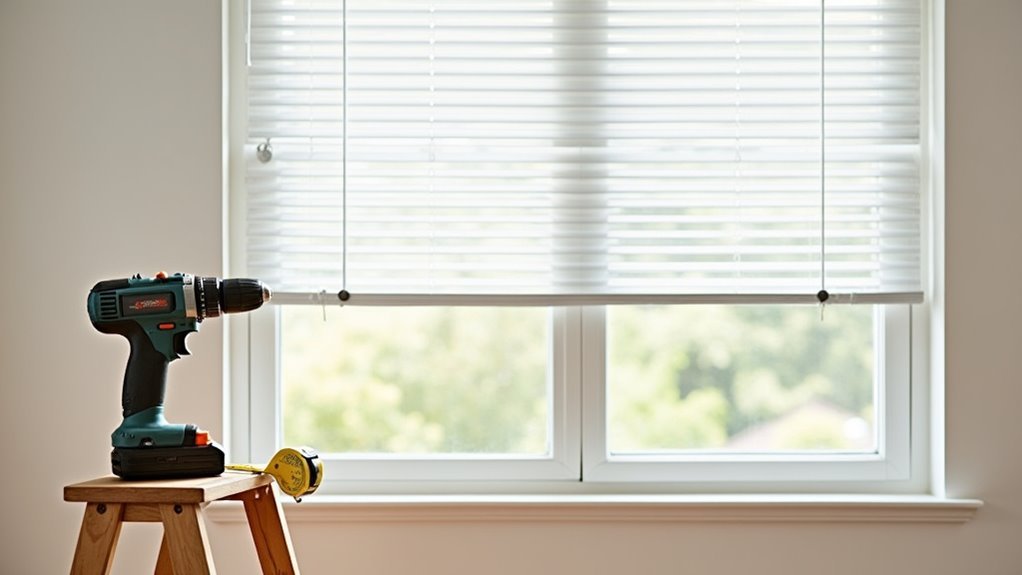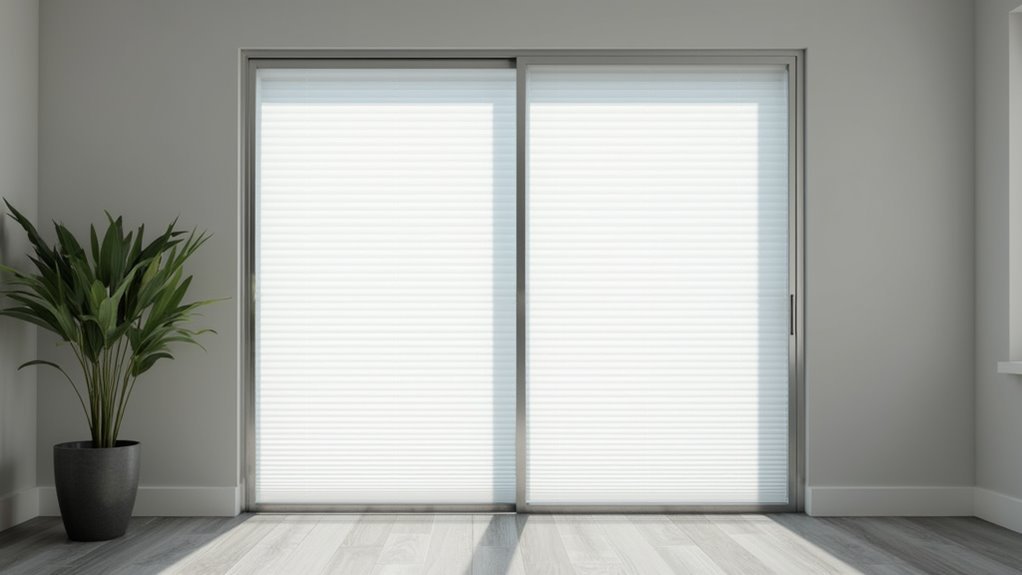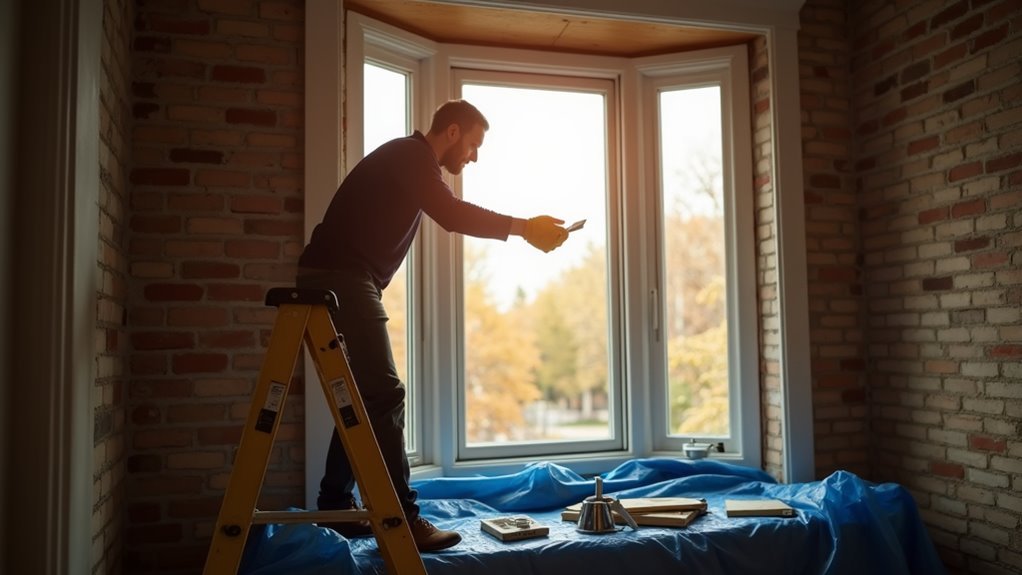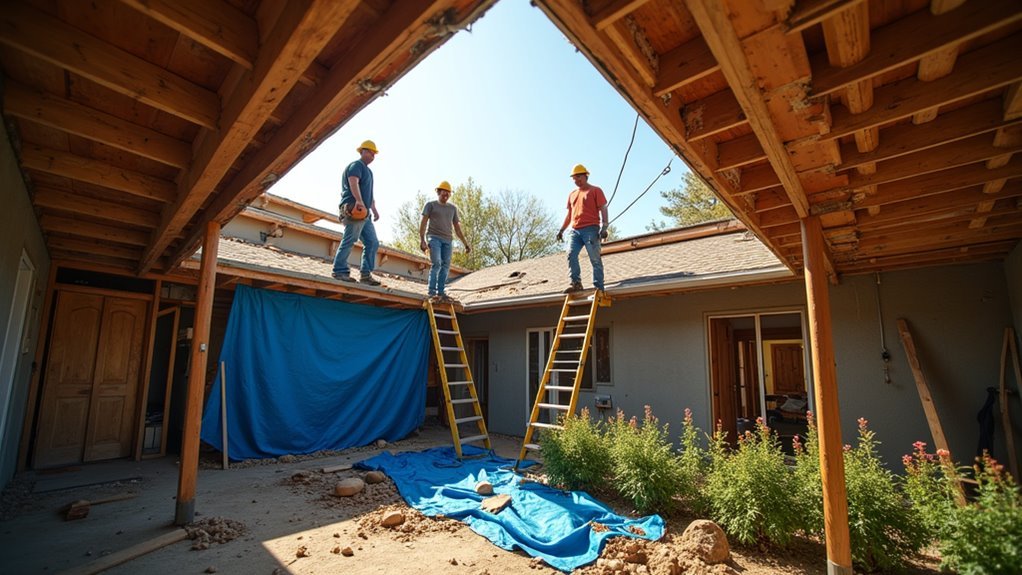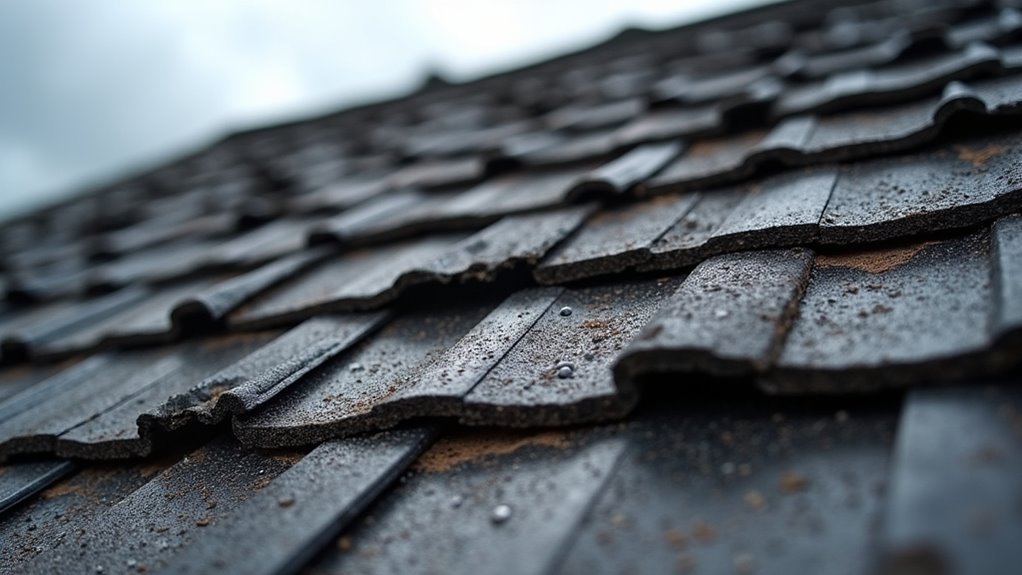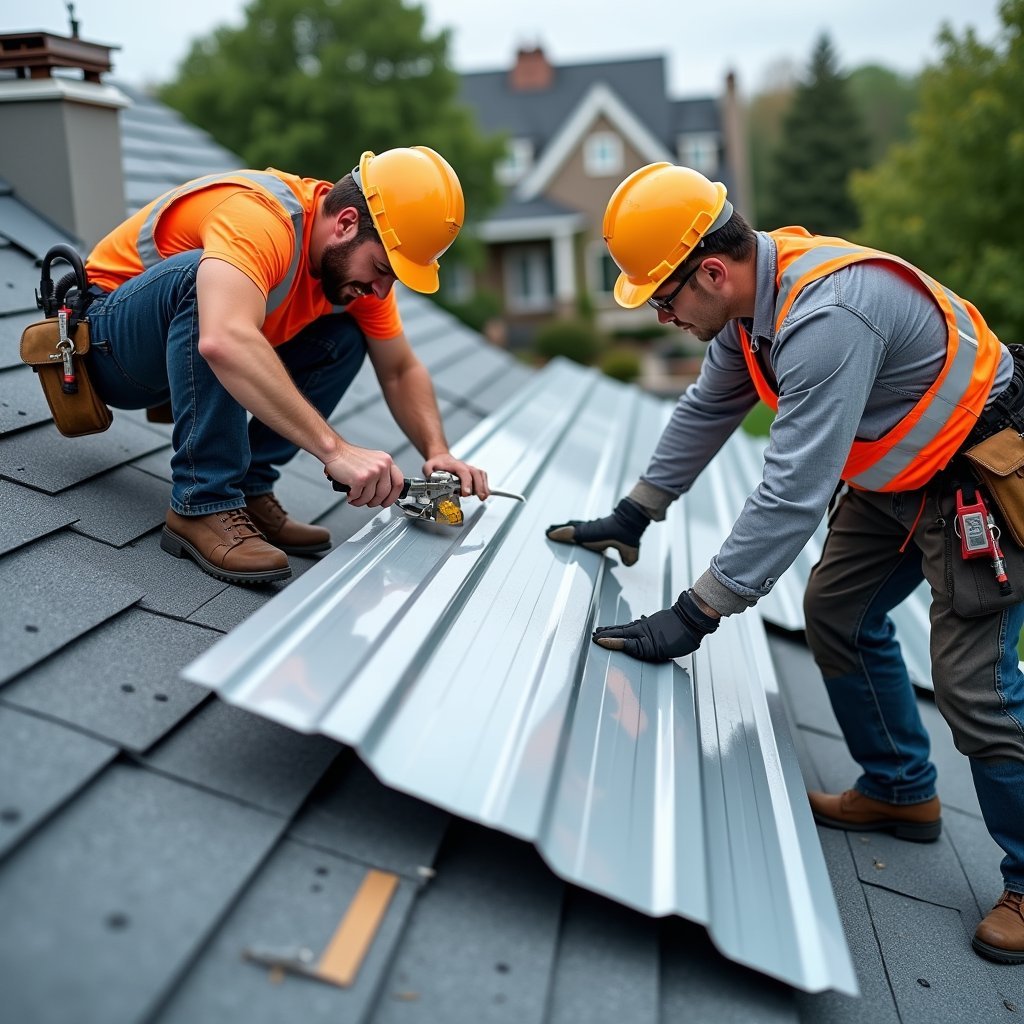You’ll need to replace your asphalt shingles when multiple signs of deterioration appear, typically between years 20-30 of installation. Watch for key indicators like granule loss in gutters, curling edges, visible cracks, or dark streaks from algae growth. While repairs might address isolated issues, full replacement becomes more cost-effective when repair expenses exceed 30% of replacement costs. Understanding your roof’s lifespan, warranty coverage, and local climate conditions will guide your ideal replacement strategy.
Common Signs of Aging Asphalt Shingles

When your asphalt shingles begin to deteriorate, several telltale signs indicate it’s time for replacement. You’ll notice shingle discoloration, with dark streaks or patches appearing across your roof’s surface, often caused by algae growth and weathering. Curling or buckling edges suggest moisture damage and deterioration-related wear, while cracked or split shingles point to structural weakness.
Watch for granule loss in your gutters and downspouts these protective minerals shouldn’t shed excessively. If you spot bare patches where granules once covered the shingle surface, your roof’s UV protection is compromised. Missing or loose shingles create vulnerable spots that can lead to leaks, and any visible sagging in your roof deck requires immediate attention. These warning signs typically appear when your shingles approach the end of their service life.
The Impact of Weather on Shingle Deterioration

Your asphalt shingles face constant exposure to ultraviolet radiation and high temperatures, which can accelerate the breakdown of their protective granules and cause the underlying materials to become brittle and curl. Strong winds from storms can lift and tear shingles away from their fasteners, while also driving rain beneath the edges of compromised sections. Heavy rain, hail, and dramatic temperature fluctuations create cycles of expansion and contraction that stress the shingles’ structural integrity and accelerate wear patterns across your roof’s surface.
Heat and Sun Damage
Over time, intense sunlight and extreme temperatures can considerably accelerate asphalt shingle deterioration. The sun’s UV exposure gradually breaks down the protective oils in your shingles, making them brittle and prone to cracking. When this happens, you’ll notice granules washing away into your gutters, leaving the underlying material vulnerable to further damage.
Daily thermal expansion and contraction cycles weaken your shingles’ structural integrity. As temperatures rise during the day, your shingles expand; when temperatures drop at night, they contract. This continuous movement creates stress points that can lead to curling, blistering, and separation at the seams. You’ll often see these effects most prominently on south-facing roof sections, where sun exposure is highest. Watch for signs like warped edges, visible bare spots, or shingles that have lost their original shape.
Storm and Wind Effects
Strong storms and high winds pose three primary threats to asphalt shingles: direct lifting force, impact damage from debris, and moisture penetration. Wind damage occurs when powerful gusts get under loose shingle edges, causing them to curl, crack, or tear away completely. Your roof’s storm resilience depends heavily on proper installation and maintenance.
You’ll need to inspect your shingles regularly for these warning signs:
- Missing granules exposing the dark asphalt substrate
- Curled or lifted edges that create entry points for wind and water
- Cracked or split shingles from impact with flying debris
- Loose or missing shingles, especially along roof edges and ridges
When you notice these issues, don’t wait to address them. Even minor wind damage can quickly escalate into major leaks and structural problems during subsequent storms.
Understanding Your Roof’s Age and Warranty

Determining when your asphalt shingles were installed represents an essential primary step in evaluating their replacement timeline. Most asphalt shingles have a typical roof lifespan of 20-30 years, but this can vary based on climate conditions and installation quality.
You’ll want to locate your warranty documentation to understand the specific coverage terms. Standard warranty coverage often includes manufacturer defects but may not cover damage from improper installation or maintenance neglect. If you don’t have the original paperwork, you can contact the manufacturer with your shingle specifications. Look for the warranty’s prorated period, which typically begins after the initial few years and gradually reduces the coverage amount over time. You should also verify if your warranty is transferable from previous homeowners and whether it’s still valid.
Essential Roof Inspection Checklist
Regular inspection of your asphalt shingles requires focusing on six critical areas: shingle condition, flashing integrity, gutter functionality, ventilation systems, interior ceiling signs, and structural alignment. Proper roof maintenance demands a thorough evaluation of these components at least twice yearly, particularly after severe weather events.
- Check for curled, cracked, or missing shingles, as these indicate advanced deterioration
- Examine metal flashing around chimneys, vents, and valleys for rust or separation
- Look for sagging roof lines or uneven surfaces that suggest structural issues
- Inspect your attic for water stains, mold growth, or daylight penetrating through gaps
Your inspection frequency should increase as your roof matures, with professional assessments recommended every three years for roofs over 10 years old. Document any changes you observe to track deterioration patterns and plan for eventual replacement.
Cost Analysis: Repairs vs. Full Replacement
When faced with roofing problems, homeowners must evaluate the immediate costs of repairs against the long-term investment of a complete replacement. While repair costs might seem more budget-friendly initially, they don’t always offer the best value over time. You’ll need to assess your roof’s lifespan, extent of damage, and future maintenance requirements.
| Factor | Repairs | Full Replacement |
|---|---|---|
| Cost Range | $300-$1,500 | $5,000-$12,000 |
| Lifespan | 2-5 years | 20-30 years |
| ROI | 30-50% | 60-70% |
The replacement benefits often outweigh patch-up solutions when your roof shows multiple issues or is past its 15-year threshold. You’ll get a new warranty, improved energy efficiency, and upgraded curb appeal. Evaluate a full replacement if repair costs exceed 30% of replacement expenses.
Choosing the Right Shingle Type and Quality
When selecting new asphalt shingles, you’ll need to choose between basic 3-tab shingles and architectural shingles, with architectural options offering improved durability and aesthetic appeal at a higher cost. Premium materials like impact-resistant or algae-resistant shingles provide specialized protection, though they represent a more significant investment than standard options. Your local climate should guide your selection, as factors like high winds, intense sun exposure, or frequent storms require specific shingle ratings and characteristics to guarantee ideal performance and longevity.
Architectural Vs Basic Shingles
Two main categories dominate the asphalt shingle market: architectural (dimensional) shingles and basic (3-tab) shingles. Your choice between these options will impact both aesthetic appeal and performance.
- Architectural shingles feature multiple layers creating a dimensional, high-end appearance that mimics slate or wood shake
- Basic shingles have a single layer with a flat, uniform pattern that’s more economical but less distinctive
- Architectural design provides superior wind resistance (up to 130 mph) compared to basic durability ratings (60-70 mph)
- Premium architectural shingles typically last 25-30 years, while basic variants average 15-20 years
When comparing costs, you’ll find architectural shingles cost 20-40% more than basic options. However, their improved durability and curb appeal often make them a worthwhile investment, especially if you’re planning to stay in your home long-term.
Premium Material Options
Beyond basic architectural shingles, premium roofing materials offer improved durability, distinctive aesthetics, and superior weather protection. You’ll find premium shingle options incorporating advanced material technologies like impact-resistant polymers, copper-infused granules for algae resistance, and improved UV protection layers.
High-end manufacturers now produce synthetic slate tiles that mirror natural stone’s appearance while weighing considerably less. Premium composite shingles feature multi-layer construction with reinforced fiberglass cores and modified asphalt formulations that resist extreme temperature fluctuations. You’ll also find luxury options with improved wind ratings up to 130 mph and Class 4 impact resistance – the highest rating available.
Consider premium materials if you’re seeking extended warranties (often 30-50 years), maximum durability, and sophisticated design elements that can raise your home’s value.
Climate-Specific Shingle Selection
Your local climate plays a fundamental role in determining the most appropriate shingle type and quality for your roof. Different climate zones require specific material durability characteristics to guarantee peak performance and longevity.
- For hot, sunny regions, choose UV-resistant shingles with high solar reflectivity ratings to prevent premature deterioration and reduce cooling costs
- In areas with frequent storms, opt for impact-resistant shingles rated for high wind resistance (130+ mph) and improved grip strength
- Cold climate zones demand shingles with superior flexibility and crack resistance to withstand freeze-thaw cycles
- Coastal environments require specialized copper-infused or algae-resistant shingles to combat moisture and prevent organic growth
Consider your region’s specific weather patterns, seasonal temperature variations, and extreme weather events when selecting your shingle specification. The right choice will greatly extend your roof’s service life and protect your investment.
Best Times of Year for Roof Replacement
When scheduling a roof replacement, timing plays an essential role in both the installation process and general project success. The fall season typically offers ideal conditions, with moderate temperatures between 45-85°F that allow proper thermal sealing of asphalt shingles. You’ll find that cooler temperatures also make the work more comfortable for installers, potentially improving their efficiency and precision.
The spring season presents another viable window for roof replacement, after winter threats have passed but before summer heat intensifies. However, you’ll need to monitor weather forecasts carefully, as spring rain can delay installation. Avoid scheduling during winter months when ice and snow create hazardous conditions, or during peak summer when extreme heat can soften shingles and make them vulnerable to damage during installation.
Professional Assessment and Installation Tips
Professional roofing assessments involve multiple critical inspection points that determine whether a full replacement is necessary. When you’re considering installation techniques, rely on professional advice to guarantee proper execution and longevity of your new roof.
- Have a certified inspector examine your roof’s decking, flashing, and ventilation system to identify structural issues that could compromise the new installation
- Request detailed documentation of problem areas, including photographs and written explanations of recommended repairs
- Verify that your chosen contractor follows manufacturer specifications for shingle installation, including proper nail placement and quantity
- Guarantee proper overlap patterns and starter strip installation to prevent future leaks and wind damage
Before proceeding with installation, obtain multiple professional assessments to compare findings and recommendations. This step helps validate the scope of necessary work and confirms you’re making informed decisions about your roof replacement.
Long-Term Benefits of Timely Replacement
Making an informed decision about roof replacement timing delivers substantial long-term advantages that extend beyond immediate repair benefits. By replacing your asphalt shingles before severe deterioration occurs, you’ll prevent structural damage to your roof deck, insulation, and interior systems. This proactive approach helps maintain increased home value while protecting your investment from costly secondary repairs.
You’ll also experience improved energy efficiency through modern shingle technology, which better reflects solar heat and provides superior insulation properties. New shingles with improved wind resistance and impact ratings can reduce your insurance premiums and offer better protection against extreme weather events. Furthermore, contemporary shingle systems often come with extended warranties, ensuring your investment remains protected for decades while maintaining peak performance throughout their service life.
Frequently Asked Questions
Can Asphalt Shingles Be Installed Over Existing Shingles?
Yes, you can install asphalt shingles over existing ones, but there are significant considerations. Most roofing regulations limit shingle layering to two layers maximum. Before adding a second layer, you’ll need to verify your roof structure can support the extra weight. While this approach can save money initially, it makes future inspections more difficult and may void manufacturer warranties. It’s vital to check local building codes before proceeding with this option.
How Long Does a Typical Asphalt Shingle Replacement Project Take?
For a typical residential roof, you’ll find that asphalt shingle replacement takes 1-3 days, depending on your home’s size and complexity. The installation timeline can extend to 4-5 days if you’re dealing with severe weather, multiple layers of old shingles that need removal, or structural repairs. Professional crews usually complete a 2,000-square-foot roof in 2 days, working systematically from tear-off to cleanup to guarantee proper shingle lifespan.
Are There Eco-Friendly Disposal Options for Old Asphalt Shingles?
Yes, you’ll find several eco-friendly disposal options for your old asphalt shingles. Recycling shingles is increasingly common, with specialized facilities processing them into materials for road construction and new roofing products. You can contact local recycling centers that accept construction waste or work with roofing contractors who partner with recycling facilities. This process transforms your old shingles into sustainable materials, reducing landfill waste and supporting environmentally responsible construction practices.
Do Solar Panels Need to Be Removed During Shingle Replacement?
Yes, you’ll need to temporarily remove solar panels during shingle replacement. The solar panel removal process requires a specialized contractor to disconnect the system, carefully detach mounting hardware, and safely store panels. This adds complexity and cost to your roof replacement considerations. Once new shingles are installed, the solar array can be remounted, but you’ll want to coordinate between roofing and solar contractors to minimize system downtime.
What Financing Options Are Typically Available for Roof Replacement Projects?
You’ll find several financing options for your roof replacement project. Traditional home improvement loans from banks offer competitive rates with longer repayment terms. Many roofing companies partner with credit financing institutions to provide specialized payment plans. You can also consider home equity loans, FHA Title I loans, or contractor-specific financing programs. Some options don’t require home equity, while others might offer zero-interest periods if you qualify for specific credit thresholds.

